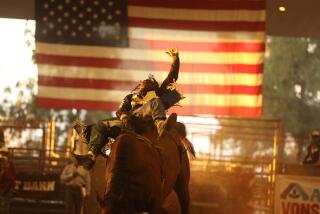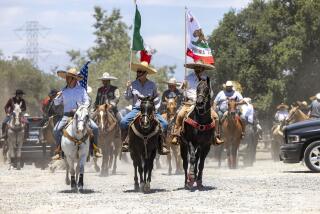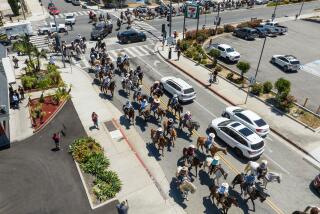Making Sure the Shoe Fits : Farriers Update Traditional Craft to Keep Area’s Horses Running
Twelve years ago, Bill Weller was a vice president of a motor-home company whose impression of horseshoeing was that it was dirty, hard work.
Today, the Newbury Park resident has traded his white-collar job for a second career as a farrier. For horseshoers like Weller, a job slinging a hammer for eight hours a day is a satisfying, if sweaty, way to make a living.
“I guess you could call us horse podiatrists,” said Weller, 44. “You’ll have a horse that’s lame, and you fix it.”
In freeway-conscious Thousand Oaks, it is easy to forget that horses were once as common as the sprawling cattle and sheep ranches that surrounded the city before it incorporated 27 years ago.
About half a dozen horseshoers still ply one of the oldest trades in history, replacing shoes for the estimated 3,000 horses in Thousand Oaks and Hidden Valley.
These days they are mobile, traveling with an anvil and a forge loaded onto the back of a pickup truck. Like Weller, some traded desk jobs to learn how to bend and hammer hot steel.
Larry Neill, 47, a former data communications engineer from Newbury Park, has shoed horses for six years. Neill said he started out just tinkering with tools.
“Horseshoeing is both an art and a science,” Neill said. “The art of being able to take shoes and fit them, and the science of making them.”
Farriers usually fashion their own sets of tools, including pritchels to punch holes in the shoes. They also carry round-head hammers, fire tongs, clippers, a drill press and sometimes a sander.
Jerry Gardner, a Thousand Oaks veterinarian who works with Weller, said some horseshoers have a bad reputation for never showing up at appointments.
Horseshoers rarely advertise, and they frown on those who do. Traveling farriers who move from town to town are dubbed “gurus.”
“Unfortunately, a fair number of farriers are fly-by-nights,” Gardner said. “They’ll tell you they’re great, and in a couple of months, they’re gone.”
But some longtime farriers earn their reputations by mastering an increasingly technical trade, Gardner said.
Many of today’s farriers have studied horseshoeing at schools in San Luis Obispo and Porterville, taking classes in equine anatomy, horse handling and how to use coal and gas forges.
Others, like Weller, mastered the trade through apprenticeship. Weller worked as an apprentice with his cousin, also a farrier in Thousand Oaks. In addition, Weller attended seminars given by the American Farriers Assn.
Weller started out in 1979 as a novice. But he soon perfected his craft and began shoeing horses at the Two Winds ranch in Newbury Park.
Now, Weller shoes about six horses a day, mostly at private riding schools. He gets up before dawn to get to his first appointment at 6 a.m. and ends the day at about 3 or 4 p.m.
Early last week, he was shoeing horses at a riding school in Ojai. On Wednesday, he shoed a horse in Simi Valley, then drove 30 miles to two ranches near Malibu.
At each location, he unloaded a 20-piece set of hand tools, a 135-pound anvil and a propane forge.
On the average, horses need to be shod every six to eight weeks. He charges about $55 a shoeing.
Annemarie Brown, a rider at the Purple Hills Ranch on Decker Road north of Malibu, said she considers Weller’s work invaluable. Because horses can become lame if improperly shod, Brown is finicky about her 11-year-old thoroughbred, Lucifer.
“He has a problem. His hoofs don’t grow fast enough,” she said. “It’s like me walking in clown shoes with high heels. You can’t fix that kind of thing overnight.”
Wellington, another horse at the ranch whom Weller has nicknamed “Beef,” doesn’t like visits from males because they are usually farriers or vets.
“This horse doesn’t like men,” Weller said as the horse sat flicking its tail. “Beef has kicked me before, so I’ve got to watch him.”
Weller clucked his tongue and spoke calmly to Beef to keep him from moving suddenly. Weller has been careful ever since a nasty kick from Beef threw the 190-pound horseshoer about 10 feet.
On this day, however, Beef was still as Weller lifted each of the horse’s four legs to trim and file the hoofs. Then he carefully pounded the nails in and trimmed the edges.
Weller said his life has changed since he left his desk job. His forearms have thickened, his hands are cut and scratched, and he has become tanned from days of working in the sun.
“I used to sit in an office, maybe go out three, four times a day to see a supervisor or a foreman and do a lot of paperwork,” Weller said as he pounded the last nail in and wiped the sweat off his brow.
“But I don’t have any ulcers anymore. I don’t have any pressure, and I’m in the fresh air,” he said. “This is what I’m going to do until I retire.”






